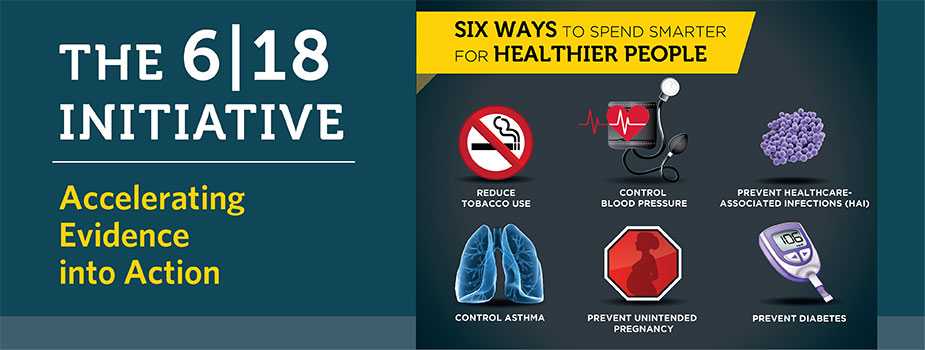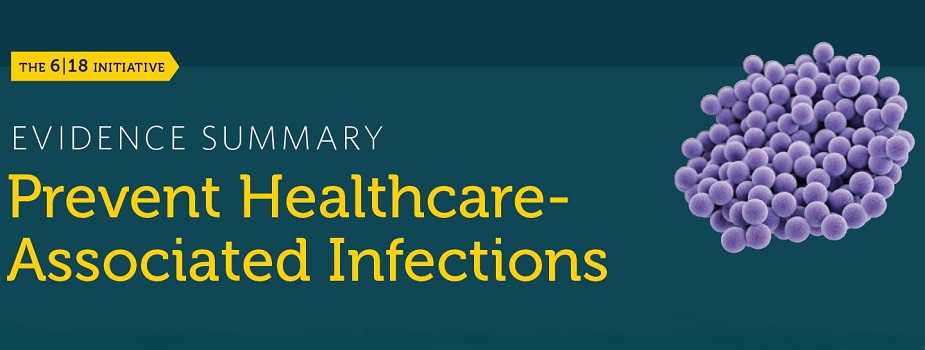New 6|18 Resources
CDC is partnering with health care purchasers, payers, and providers to improve health and control health care costs. CDC provides these partners with rigorous evidence about high-burden health conditions and associated interventions to inform their decisions to have the greatest health and cost impact. This initiative offers proven interventions that prevent chronic and infectious diseases by increasing their coverage, access, utilization and quality. Additionally, it aligns evidence-based preventive practices with emerging value-based payment and delivery models.
By 6|18, we mean that we are targeting six common and costly health conditions – tobacco use, high blood pressure, healthcare-associated infections, asthma, unintended pregnancies, and diabetes – and, initially, 18 proven specific interventions that formed the starting point of discussions with purchasers, payers, and providers. The number of interventions may fluctuate over time.
Download a fact sheet about the 6|18 Initiative here.
6|18 Initiative: Key Actions
Key actions of this initiative include bringing together health care purchasers, payers, and providers with CDC researchers, economists, and policy analysts to offer opportunities to improve health and control costs with the 6|18 interventions. In these new partnerships, CDC:
- Provides technical assistance to state Medicaid programs in partnership with public health departments to implement prioritized 6|18 interventions based on state needs and readiness.
- Is working with 9 State Medicaid Agency-Public Health Department teams to understand and disseminate best practices for implementing 6|18 interventions.
- Provides technical assistance to private payers to identify 6|18 interventions that will help their beneficiaries.
- Collaborates with health care providers who are increasing their ability to deliver the 6|18 interventions that improve preventive services and patient care.
High-Burden Health Conditions and Evidence-Based Interventions
The following is a list of high-burden health conditions with effective interventions that CDC is prioritizing to improve health and control health care costs.
Reduce Tobacco Use
- Expand access to evidence-based tobacco cessation treatments, including individual, group, and telephone counseling and FDA-approved cessation medications—in accordance with the 2008 Public Health Service Clinical Practice Guidelines.
- Remove barriers that impede access to covered cessation treatments, such as cost sharing and prior authorization.
- Promote increased utilization of covered treatment benefits by tobacco users.
Control High Blood Pressure
- Promote strategies that improve access and adherence to anti-hypertensive and lipid-lowering medications.
- Promote a team-based approach to hypertension control (e.g., physician, pharmacist, lay health worker, and patient teams).
- Provide access to devices for self-measured blood pressure monitoring for home-use and create individual, provider, and health system incentives for compliance and meeting of goals.
Prevent Unintended Pregnancy
- Reimburse providers for the full range of contraceptive services (e.g., screening for pregnancy intention; tiered contraception counseling; insertion, removal, replacement, or reinsertion of long-acting reversible contraceptives (LARC) or other contraceptive devices; and follow-up) for women of child-bearing age.
- Reimburse providers or health systems for the actual cost of LARC or other contraceptive devices in order to provide the full range of contraceptive methods.
- Reimburse for immediate postpartum insertion of LARC by unbundling payment for LARC from other postpartum services.
- Remove administrative and logistical barriers to LARC (e.g., remove pre-approval requirement or step therapy restriction and manage high acquisition and stocking costs).
Control Asthma
- Promote evidence-based asthma medical management in accordance with the 2007 National Asthma Education and Prevention Program guidelines.
- Promote strategies that improve access and adherence to asthma medications and devices.
- Expand access to intensive self-management education for individuals whose asthma is not well-controlled with guidelines-based medical management alone.
- Expand access to home visits by licensed professionals or qualified lay health workers to improve self-management education and reduce home asthma triggers for individuals whose asthma is not well-controlled with guidelines-based medical management and intensive self-management education.
Prevent Diabetes
- Expand access to the National Diabetes Prevention Program, a lifestyle change program for preventing type 2 diabetes.
- Promote screening for abnormal blood glucose in those who are overweight or obese as part of a cardiovascular risk assessment.
- Page last reviewed: October 3, 2017
- Page last updated: October 3, 2017
- Content source:


 ShareCompartir
ShareCompartir







